| Duration: | 04/2020 - 03/2025 |
| Contracting Authority/ Sponsors: |
Bundesministerium für Ernährung und Landwirtschaft (BMEL); Ministerium für Umwelt, Energie, Ernährung und Forsten des Landes Rheinland-Pfalz (MUEEF) |
| Project Partners: | Bio-Obsthof Nachtwey; BayWa r.e. Solar Projects GmbH; Dienstleistungszentrum Ländlicher Raum Rheinpfalz (DLR); Elektrizitätswerke Schönau EWS, Vertriebs GmbH; AGCO GmbH |
| Website: | |
| Project Focus: |
APV-Obstbau (Orcharding) – Agrivoltaics as Resilience Concept for Adaptation to Climate Change in Orcharding
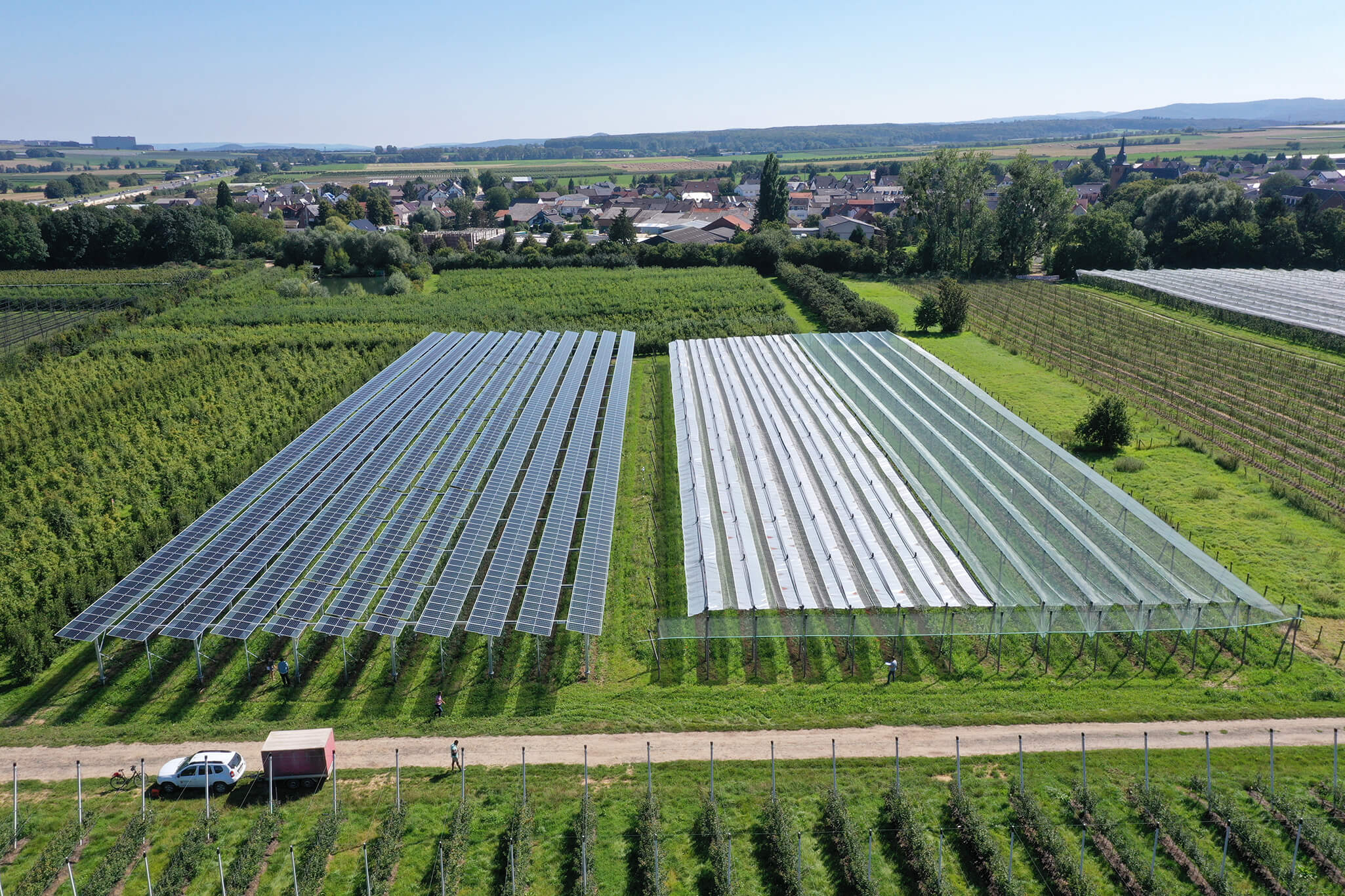
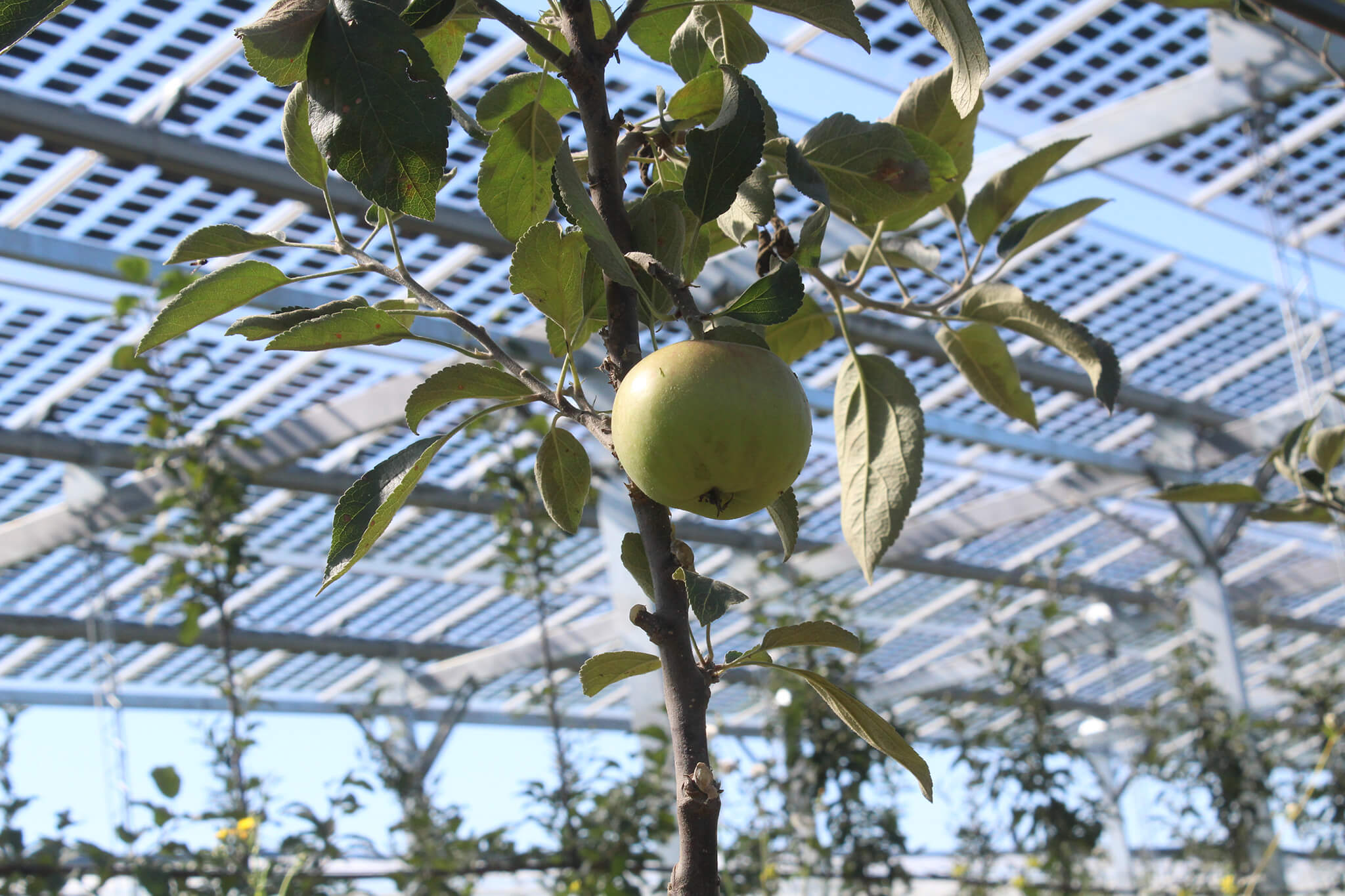
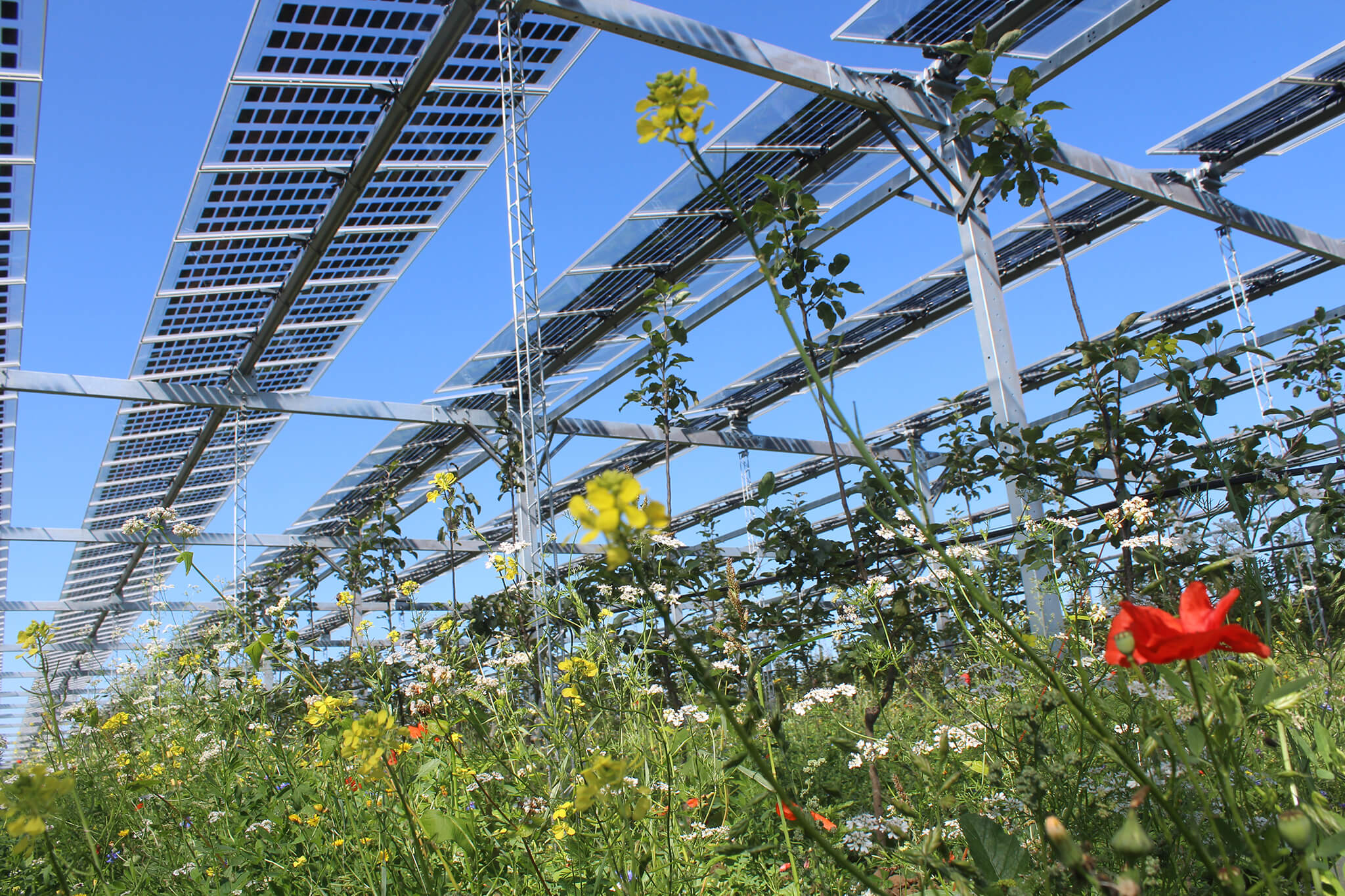
The agricultural sector is facing new challenges. In the wake of climate change, strategies must be developed to avoid negative impacts on harvests. Orcharding in Germany is already affected by the consequences of climate change: rising temperatures, changes in precipitation distribution and increasingly frequent extreme weather events such as hail and heavy rain. As a result, commercial fruit growers are increasingly using hail protection nets and foil roofing to prevent quality and yield losses.
The project "APV-Obstbau" (Agrivoltaic Orcharding) will investigate to what extent agrivoltaics can replace these protective measures in apple cultivation, which system design makes sense for this crop and in which way the agrivoltaic system affects crop yields.
The goal of the project is an increased resilience in fruit production as well as dual and resource efficient use of land. Land use competition between ground-mounted photovoltaic systems and agriculture can thus be counteracted.
The system design of the installed agrivoltaic system is adapted to the practical requirements of commercial organic fruit farming so as not to restrict efficient farming. In addition, the canopy provided by the agrivoltaic system is designed to replace the protective structures traditionally used in fruit growing, such as hail protection nets and foil roofing. The crop can thus be protected from harmful environmental influences. A possible reduction in the application of plant protection products is also being examined.
The goal for the fruit growing in the agrivoltaic system is not primarily to maximize crop production, but to provide secure and high quality apple yields with additional solar power production. The generated electrical energy is to be used in the upstream and downstream areas of apple production, for example, by using electrified agricultural machinery, operating irrigation systems, or in the storage of the apple harvest in the electrically operated cold store.
The research facility was established in Gelsdorf in the Rhineland in the spring of 2021. The installation will make it possible to analyze the practicality of the developed concept under real conditions. For this purpose, the Agri-PV orchard will be examined in particular with regards to light management, plant design, landscape aesthetics, its economic efficiency, social compatibility and on the basis of agronomic parameters.
The plant includes five experimental variants: (1) control variant with standard hail protection nets, (2) control variant with foil roofing (3) fixed agrivoltaic system with PV cells in spatially separated zebra design (4) tracked agrivoltaic system with PV cell array in block design (5) fixed agrivoltaic system with PV cell array in block design.
Eight different apple tree varieties with different sensitivities to diverse environmental factors were planted to study the crop management parameters. This allows a better understanding of the compatibility of crop demands with an agrivoltaic system. First results are expected with the first full harvest in the fall of 2023.
The social acceptance and social compatibility part of the project addresses potential conflicts (land use, distribution, a just process management) within different affected constellations of interests. In addition, citizen events will be organized, an agrivoltaic fruit-growing guide will be developed for fruit-growing farms, and the chances of integrating agrivoltaics into the existing climate plan will be examined with local decision-makers.
The project consortium has compiled an overview of the most frequently asked questions regarding the implementation of the plant, the economic efficiency as well as the research concept.
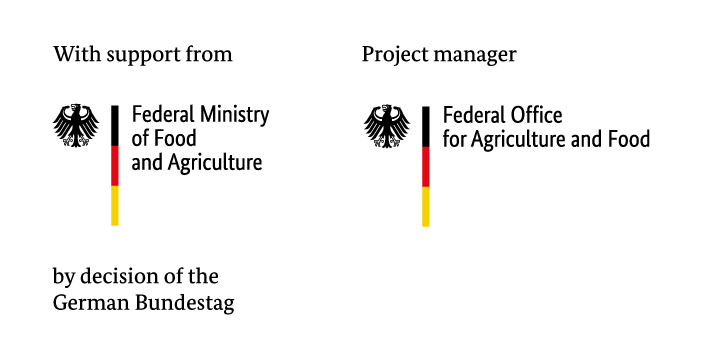
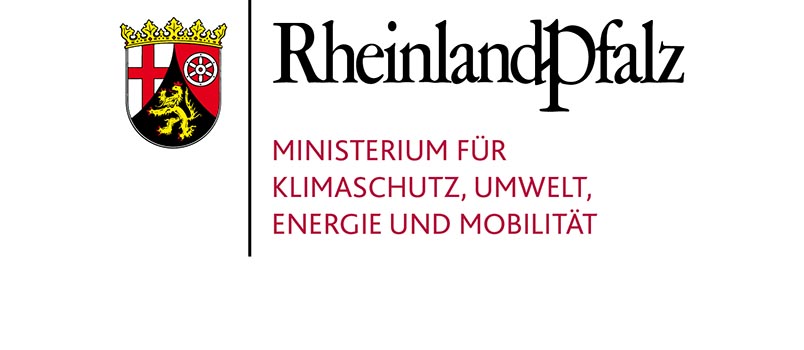
Further Information:
Questions & Answers about the research project "APV Obstbau"
Introduction
How did you come up with the idea of building an APV system?
The idea to scientifically test an APV concept in the district of Ahrweiler goes back to the initiative of the local politician Mr. Wolfgang Schlagwein, who was able to establish contacts in politics as well as with Fraunhofer ISE already at the end of 2017.
Based on the idea of the project that had been developed in Heggelbach at the time, Mr Schlagwein initiated the first meetings with representatives from research (ISE), the cultivation advisory service of the state of Rhineland-Palatinate (DLR Rheinpfalz) and state politics in Mainz at the beginning of 2018.
The potential use of synergies between the two systems quickly became apparent and the decision to advocate for the municipality of Grafschaft as a possible research location was concretised.
The proximity to the DLR Rheinfalz research site in Klein-Altendorf and previous research projects on the energy transition for the entire Ahrweiler district, such as EnAHRgie, favoured this decision.
The involvement of the Nachtwey organic orchard was considered to be particularly effective due to their direct willingness to support the project in 2017 and due to the particular relevance in organic production methods with regard to the feasible rain protection and the effects on biodiversity.
How long was the planning period for the APV plant?
A good four years of intensive planning passed between the start of the first discussions on the basic topic of APV in 2018, the approval of the funding decision by the state government and the federal government, and the start of the construction measures in May 2021.
The concrete development of a system concept for the roofing in the pome fruit orchard, taking into account the most diverse concerns from an agricultural, research-technical and static-structural perspective, took a good 2 years alone.
In the end, a versatile and functional system design was developed, which can be used to address a wide range of issues relating to the topic of DIN-SPEC category 1 agri-photovoltaics.
What was or is the biggest hurdle with the APV plant?
The biggest hurdle was obtaining planning permission. A privileged building permit procedure according to § 35 para. 1 no. 4 of the German Building Code (BauGB) was carried out. Among other things, plant and construction descriptions, site plans, construction drawings, statics tests, soil expertises as well as expertises on nature conservation and land management had to be submitted. Since the building permit obtained in this way is only valid for the duration of the project, an urban land use planning procedure must be initiated by 2023 so that the facility can continue to exist beyond the research project.
What positive things can be reported about APV plant so far?
We are still at the beginning of the trial phase. Therefore, further aspects will follow. The following positive aspects can be noted so far.
If you are underneath the system, the shading provided by the modules appears to be very well dimensioned. This means that one can assume that the shading will have little influence on plant growth. This will hopefully be shown by future research results.
Another positive aspect is the lower noise level under the APV system compared to the film- and net-covered surfaces.
In addition, the APV system arouses great interest among many visitors and the public. The plant is perceived positively as a future-oriented concept with potential for synergies between electricity production and agriculture. The elimination of plastic roofing is also perceived as positive. For the farmer, the advantage is that no recurring installation work is necessary, as in the case of hail protection nets and foils.
What are important findings and suggestions for improvement so far?
Due to the very short period of time until planting, the project had to be planned and constructed quickly. Therefore, the amount of steel and the design of the APV system could not yet be optimised, resulting in higher costs. On the other hand, the project participants can learn from this and optimise and further develop future projects in this respect.
In addition, the soil was adversely affected during construction, in particular due to heavy compaction of the soil. Therefore, the soil had to be loosened again before planting the apple trees.
In addition, the rainwater drainage edge of the modules is offset by about a third between the rows of trees and falls exactly into one of the two lanes of the electric narrow-track tractor. In future, the drip edge should be as central as possible between the rows of trees, as with the foil protection system of the reference area. In this way, double loading of the tramline vegetation between the rows of trees by rain and the tramline can be avoided.
In general, the food-energy nexus was very well considered in the research design, but the water aspect was underestimated. In cooperation with the farmer, DLR Rheinpfalz, BayWa AG and BayWa r.e., a subsequent integration of a fully automatic and digital irrigation and frost protection system is planned for 2022 so that this weak point in the experimental design can be remedied.
In addition, the trees get wet in the lower third (leaves) during lateral rainfall. However, since the main yield zone will later not be in this area, which is now wet due to the "only" 2 m wide modules, the tree virtually grows into the shelter. So far, the effects are not very dramatic, because only a long period of leaf wetness leads to an infection with apple scab. We hope that the periphery will dry out quickly so that this should not be a problem.
Construction of the plant
What was your procedure for the construction?
The design of the plant was prepared by the architect Joachim Kleimann and completed with the granting of the building permit. The construction management and construction were supervised by Fraunhofer ISE and BayWa r.e..
A total of eleven specialist authorities were involved, including the municipality of Grafschaft, the district administration of Ahrweiler, the Rhineland-Palatinate Chamber of Agriculture and the environmental and state conservation authorities. The decision-makers for the construction of the plant were the municipality of Grafschaft and the district administration of Ahrweiler.
For the construction of the plant, a building application procedure in the simplified approval procedure and thus a facilitation of the building permit was achieved. The research project can only be carried out in an outdoor area because of the special demands on the surroundings or because of its special purpose. Approval was granted in accordance with BauGB §35, Para. 1, Sentence 1, No. 4. The building permit is limited to five years. Therefore, there is currently no decision on the development plan. A development plan must be submitted by Fraunhofer ISE within the next three years. The costs for this have already been requested. This must be tackled in about two and a half years, so that a legally binding building permit with decisions on site development will be available in about three years.
With regard to the land use plan, there are no changes as the area continues to be used intensively for agriculture.
Could you have built your plant even bigger?
Technically, a larger plant would have been possible. However, due to the framework conditions on site, the research design and the budget, this was not possible.
Has there been any opposition to the plan?
So far, there has been mainly positive feedback and a lot of public interest in the plant. The research project and the construction of the plant were supported by the administration and the authorities.
An initial survey of various interest groups on site - including representatives of the administration, the energy sector, environmental and species protection associations, the agricultural sector, farmers' associations, local politics and science - confirms this positive picture.
Although questions regarding the landscape, economic and financial viability as well as the legal framework have been raised, the answers to these questions are still pending as part of the research study. The same applies to the practicality, the energy yield and the negative and positive environmental impacts of the system, if any.
At the same time, APV is seen by the majority as a technology of the future that not only counteracts the competition for land use between the energy and agricultural sectors, but above all can enable yield security in agricultural production. Agriculture is already suffering from the consequences of climate change (heavy rain, hail, extreme solar radiation, etc.). The farmer family Nachtwey informs residents and the local population in personal exchanges, through information meetings and information events about the problems they are facing due to climate change and how the system will benefit them. This makes it comprehensible for local residents, so that the majority of them have a positive attitude towards the plant.
Fraunhofer ISE is pursuing further communication strategies (e.g. information events on site, lectures and talks on site, further surveys, etc.) to provide information about the plant and to include the concerns, wishes and impressions of local residents and interest groups. In this way, the broadest possible social support for the plant is to be achieved.
How is the electricity from the APV system fed into the grid?
The electricity is fed into the medium-voltage grid of the energy operator Westenergie via a transformer yet to be installed in the direct vicinity of the APV system. Self-use of the PV electricity is possible without feeding it into the medium-voltage grid for watering the fruit trees and charging the electric tractor.
Did you have any problems laying the power cables?
As the cables are short, there were no problems.
Did you have to provide compensation areas or similar for the construction?
Compensatory areas do not have to be provided. However, production-integrated compensation measures (e.g. planting and adapted cultivation/maintenance of flowering strips in the tramline, high herbaceous swamps, nesting aids for birds and insects, anchor plants, shrub groups, rock piles, deadwood piles) and compensation payment of € 300.00 for non-compensable impairments of the landscape take place.
These measures were specified in the nature conservation study, § 14 BNatSchG and § 9 LNatSchG Rhineland-Palatinate with integrated preliminary species protection assessment as an appendix to the planning application. The measures were defined in consultation with the Nachtwey fruit farm.
Economic efficiency
What are the initial costs of an APV system?
The investment costs of an APV system depend on its application. Central influencing factors are: the size of the APV system measured in terms of the installed capacity (economies of scale: Fixed costs, e.g. grid connection, are distributed over a higher installed capacity and thus annual generated electricity, which reduces the costs per generated kWh), the height of the system or the complexity of the substructure (material costs), the solar modules used (since special modules are not yet widely used, the costs of these can be significantly higher than conventional PV modules).
How did you finance the plant?
The project, and thus the APV system, is financed by two funding bodies: the Ministry for Climate Protection, Environment, Energy and Mobility of Rhineland-Palatinate (MKUEM) and the Federal Ministry of Food and Agriculture (BMEL). Income from electricity revenues was offset against the funding.
How much time do you have to invest in the plant per week/month?
Four project partners (Fraunhofer ISE, BayWa r.e., DLR Rhineland-Palatinate and the organic fruit farm Nachtwey) were mainly involved in the development of the system. In bi-weekly meetings and supplementary bilateral discussions, the APV research facility and its approval and implementation were planned and prepared over a period of six months. This was also so time-consuming and labour-intensive because this is the first APV facility in apple cultivation in Germany.
Operating and maintenance costs per year?
With regard to operation and maintenance, costs are incurred, for example, for repair and maintenance work, spare parts, data monitoring and remote monitoring. In addition, a distinction must be made between commercial and technical operating costs. The technical operating costs are estimated at 16-18 €/kWp per year. This assumption still needs to be verified by research.
Operating hours per year?
The total yield in the first year of operation was calculated at about 276 MWh. This needs to be validated in practice.
Yield per kWp?
The yield varied from module to module and elevation from 1006 to 1199 kWh/kWp and is on average 1068 kWh/kWp.
Were you able to provide partial services for the construction of the system yourself in order to save money?
In this research project, we did not provide any services ourselves. It would be conceivable to carry out part of the implementation with equipment such as that available to farmers through machinery rings for the installation of other protective constructions (e.g. hail protection nets). This could reduce the costs of installation. However, it is questionable to what extent the machines and the know-how are sufficient for this.
What do you do if, for example, your inverter or a module fails?
These must be replaced promptly. This must be taken into account in the budget planning when calculating the operating costs over the life of the system.
How long are the guarantees for the modules?
The product warranty is 12 years, the performance warranty 30 years. The inverter warranties are 10 years.
What is your plan after the tariff expires?
There is no feed-in tariff for the system under consideration according to the EEG. A power supply contract will be used. The Power Purchase Agreement (PPA) for this is currently being drawn up.
Concept of research
How will the system be studied?
The APV system is being investigated from an agricultural science perspective, as well as with regard to its energy yield, economic efficiency, social compatibility, its land potential in Germany, nature conservation aspects, practicality on the farm and the surrounding policy field.
Furthermore, different crop protection systems are compared with each other by installing areas with hail protection nets and foil roofing in addition to the APV system. The comparison of the different hail and crop protection systems was made possible by BayWa AG, specifically the hop and fruit trading centre in Tettnang on Lake Constance, which installed the two protection systems.
Performance data and specifications of the plant
How many modules does your system have?
The research system consists of 8 rows with fixed mounting and 106 modules each, as well as 3 rows with tracked mounting and 100 modules each.
What is the capacity of your system?
The system has an installed capacity of 258.3 kWp.
Why did you choose these solar modules?
The solar modules were specially made for this project. Their design is based on the assumption that the shading below the modules must not be significantly more than 30%. This value is the result of a study on shading by hail nets.
The comparison of both PV module types "core shading above the treetop" and "zebra design with uniform light distribution" will hopefully be reflected in the crop yields so that valid statements can be made about the more suitable module type.
Conclusion and highlights of the facility
Would you built the system again?
Yes, because the symbiosis of both systems seems to make sense.
If you were to built such a system again, what would you do differently?
This question can only be answered definitively after the end of the research project. However, the first months of system operation have shown that longer modules would be advantageous, as the drip edge of the modules would then be in the middle of the tramline.
"Climate-positive" fruit from Germany?
Particularly worth mentioning is the electric water pump and the idea of a "climate-positive" apple, which is not only "climate-neutral" but also makes a positive contribution to climate protection by electrifying the farmyard. Farmers face the challenges of meeting ever-increasing sustainability demands from the food retail sector while at the same time having to invest in climate change adaptation. APV enables investments to be leveraged from the energy sector into agriculture and helps decarbonise the food supply system. The research project will reveal the exact impact of this on the carbon footprint of the apple.
The questions and answers were compiled by:
Dr. Sebastian Gölz & Franziska Larisch from Fraunhofer ISE
Co-authors:
Albert Schlaak, BayWa r.e.
Alexander Rau, BayWa r.e.
Andreas Steinhüser, Fraunhofer ISE
Joachim Kleimann, KG Architecture Kleimann Grones PartG mbB
Johannes & Christian Nachtwey, Organic fruit farm Nachtwey
Michaela Hopf, Fraunhofer ISE
Martina Zimmer, DLR Rhineland-Palatinate
Stephan Schindele, BayWa r.e.
Thies Stillahn, EWS Schönau